What Are the Seven Continents? An Explorer's Guide
Discover the answer to 'what are the seven continents' in our complete guide. Explore maps, key facts, and the unique stories of each of Earth's landmasses.
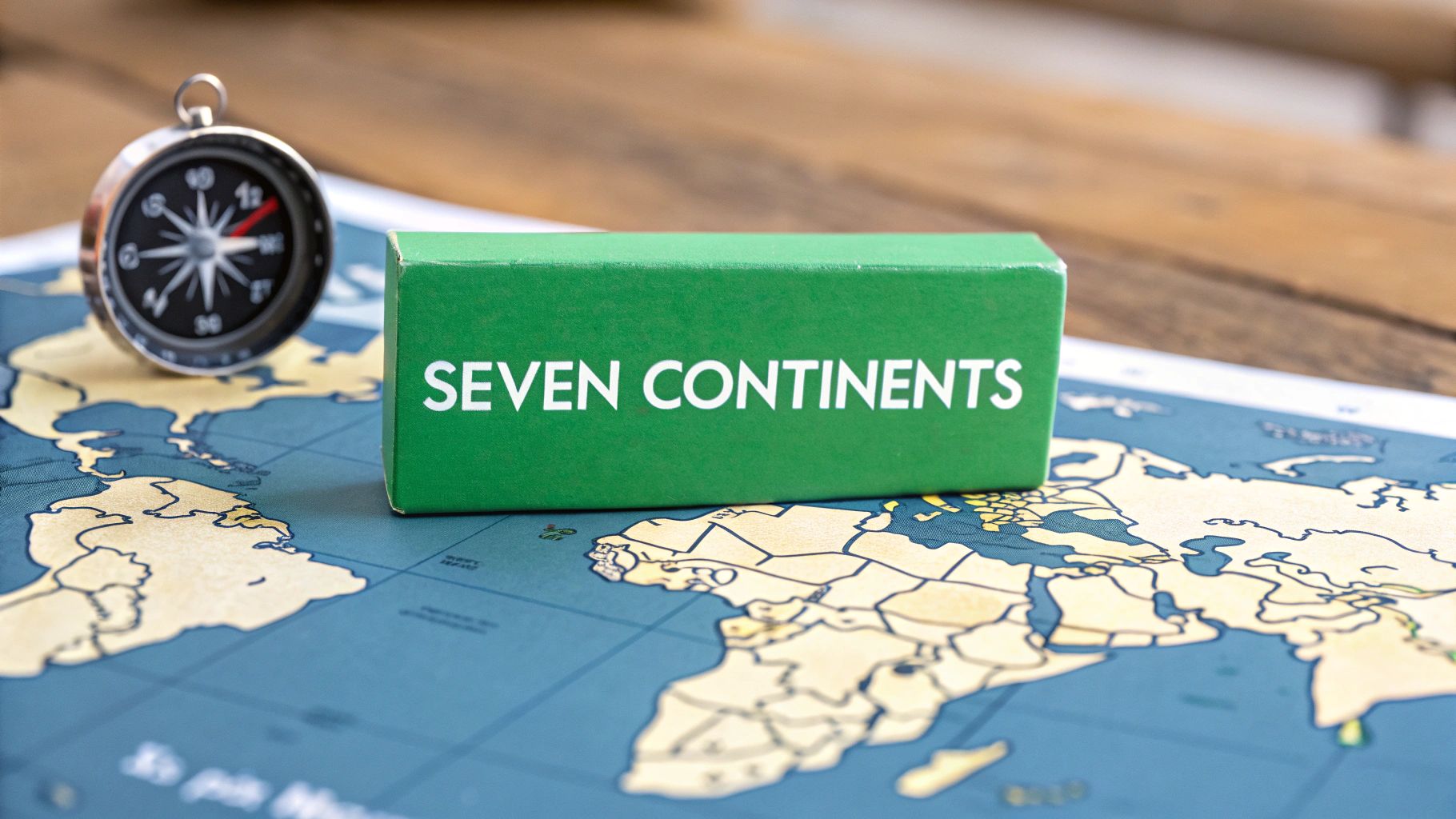
Let’s get right to it: the seven continents are Asia, Africa, North America, South America, Antarctica, Europe, and Australia/Oceania. But simply listing them out is like looking at a map without knowing any of the stories behind it. This guide is your starting point, your world map, for the incredible adventures that await in EarthChasers.
Mapping Our World's Continents
The idea of seven continents is really just a way we’ve decided to carve up the world’s biggest pieces of land. It’s a model based on a mix of geography and culture that’s been passed down for generations.
Some borders are obvious—you can’t miss the massive oceans separating the Americas from Africa and Europe. Others, like the line between Europe and Asia, are more of a cultural agreement than a physical barrier. This way of organizing the globe helps us make sense of our planet’s incredible diversity, where every continent has a completely different story to tell.
A Look at the Largest Landmasses
The sheer scale of these landmasses is wild. Asia isn't just the biggest; it's a true giant, dwarfing most of the others in both size and population. As of 2025, it's home to over 62% of all people on Earth. That single stat gives you a sense of its massive global influence. If you're curious, you can discover more insights about continental populations and see exactly how they all stack up.
To give you a better feel for just how big these landmasses are, this chart breaks down the top three by land area.
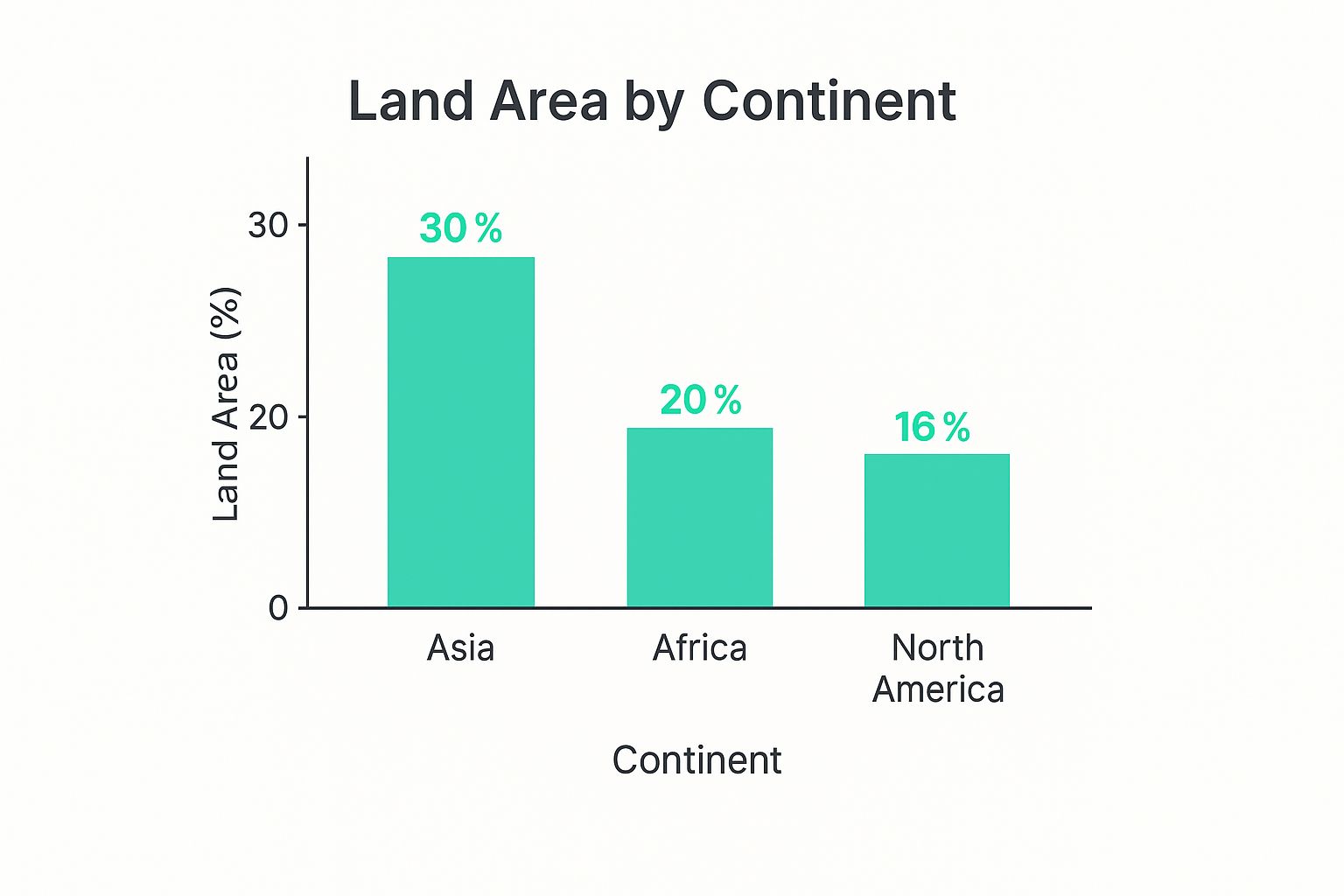
When you see it laid out like that, it really hits home: Asia and Africa combined make up a full half of our planet's land. That’s a staggering amount of territory to explore.
To put it all in one place, here’s a quick-glance table with the key numbers for every continent.
The Seven Continents at a Glance
This table gives you a snapshot of each continent, showing how they compare in both population and physical size. It’s the perfect cheat sheet for understanding the world's layout before you dive into your first EarthChasers challenge.
| Continent | Estimated Population | Area (sq km) |
|---|---|---|
| Asia | 4.75 Billion | 44,614,000 |
| Africa | 1.46 Billion | 30,365,000 |
| North America | 605 Million | 24,230,000 |
| South America | 439 Million | 17,840,000 |
| Antarctica | ~1,000-5,000 (non-permanent) | 14,200,000 |
| Europe | 742 Million | 10,180,000 |
| Australia/Oceania | 45 Million | 8,525,989 |
Looking at these numbers, you can see the huge disparities across our world—from the bustling hubs of Asia to the icy, empty expanse of Antarctica. Each one offers a totally unique set of challenges and discoveries.
Asia: The Largest and Most Populous Continent
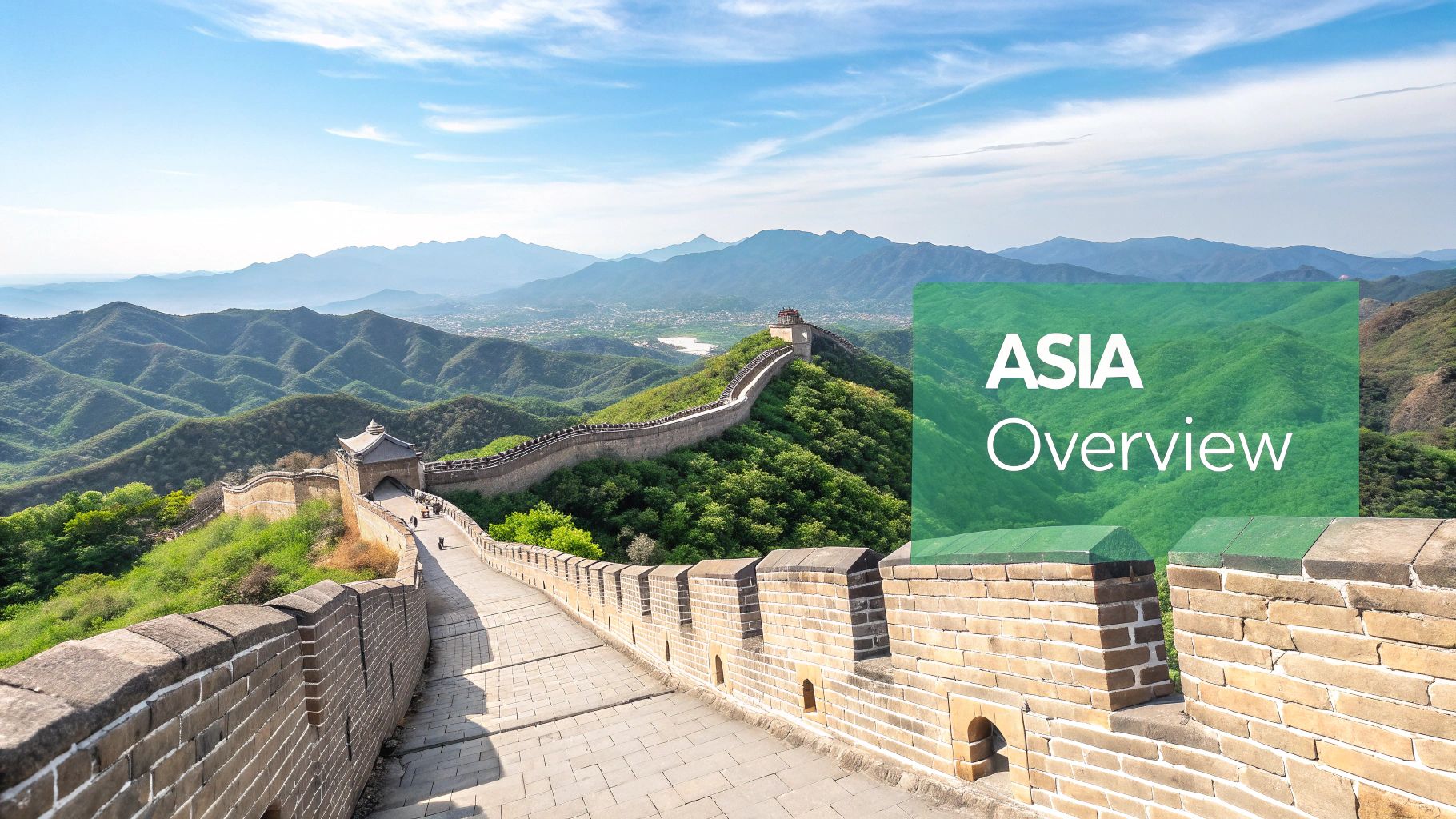
When you’re wrapping your head around the seven continents, Asia is the best place to start. Why? Sheer scale. It’s not just the largest continent by land area—covering nearly a third of the Earth’s surface—it’s also home to more than half of the world's entire population. That immense size creates an unbelievable tapestry of cultures, landscapes, and histories.
Think about it: a single landmass that holds both the highest point on Earth, Mount Everest, and the lowest, the Dead Sea. This staggering range of geography is what defines Asia. Its environments are just as varied, from the frozen tundra of Siberia and the steamy tropical rainforests of Southeast Asia to the vast, arid deserts of the Middle East. That diversity is a recipe for endless adventure.
In EarthChasers, you can feel that scale firsthand, tackling missions that take you from the snowy peaks of the Himalayas to the bustling, futuristic streets of Tokyo.
A Continent of Contrasts
Asia is where ancient traditions crash into modern ambition. You can find thousand-year-old temples nestled right beside gleaming skyscrapers. This contrast is the heart of its identity. It’s a place where you can trek the historic Great Wall of China one day and explore a high-tech hub the next.
Asia's dynamism comes from this blend of old and new. It's home to some of the world's fastest-growing economies while also being the birthplace of major world religions like Hinduism, Buddhism, and Islam.
This fusion of history and progress is a core theme in many EarthChasers quests. To explore Asia is to engage with a living history that is constantly evolving. Your journey might involve:
- Navigating megacities: Get lost in the vibrant energy of places like Mumbai or Beijing.
- Exploring ancient wonders: Uncover the secrets of world heritage sites like Angkor Wat in Cambodia.
- Surviving extreme environments: Put your skills to the test in the Gobi Desert or across the Siberian plains.
Africa: Cradle of Humankind and Natural Wonders
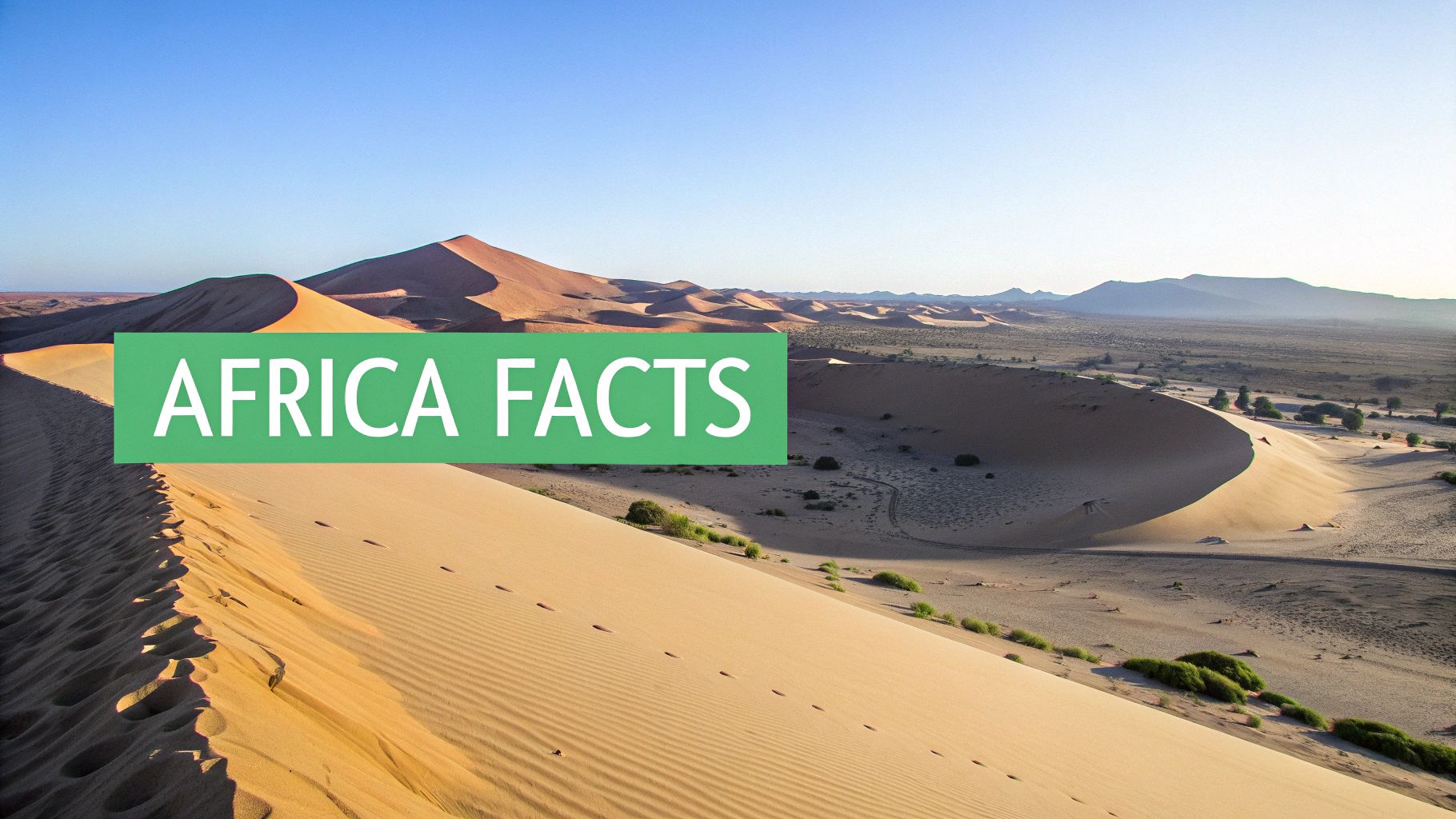
When we talk about Africa, we’re talking about the very beginning of the human story. It’s rightfully called the “cradle of humankind,” the place where scientists have unearthed the oldest evidence of our ancestors. This incredibly deep history is the foundation for a continent overflowing with jaw-dropping natural beauty and a staggering amount of diversity.
You’ve got the Sahara, the largest hot desert on Earth, stretching across the north, and the dense, green rainforests of the Congo Basin at its heart. Africa’s landscapes are immense and varied, from the iconic savannas of the Serengeti—home to an unparalleled concentration of large mammals—to the soaring peaks of Kilimanjaro. It’s a global hub for biodiversity.
In EarthChasers, your missions will drop you right into this incredible scope. One day you might be tracing the path of the Nile, the longest river in the world, and the next you could be navigating the labyrinthine waterways of the Okavango Delta.
A Continent of Growth and Diversity
Africa’s diversity isn’t just in its landscapes. It’s a tapestry woven from over 3,000 distinct ethnic groups who speak more than 2,000 languages. This rich cultural mosaic is set against a backdrop of rapid growth and modern innovation.
Africa’s population dynamics tell a story of a continent on the move. Its future is being shaped by its youthful population, vibrant cultures, and growing cities, creating a unique blend of tradition and modernity.
When you look at population distribution across the seven continents, Africa’s path is unique. It has the highest growth rate—over 2% annually—a pace that could see its population nearly double by 2100. That’s a stark contrast to other parts of the world where populations are leveling off. You can dive deeper into the data on global population trends to see how Africa's growth is reshaping our world.
This dynamism makes Africa an exhilarating place to explore. Your adventures could involve:
- Wildlife Conservation: Take on challenges to protect endangered species in iconic national parks.
- Cultural Exploration: Uncover the history of ancient kingdoms in places like Egypt or Ethiopia.
- Urban Adventure: Navigate the bustling, energetic markets of Lagos or Nairobi.
North and South America: Two Continents of Extremes
We often lump them together as "the Americas," but North and South America are two completely distinct continents, each with its own incredible range of environments and cultures. They’re a classic example of how two landmasses, connected only by a tiny thread of land, can evolve in wildly different ways.
North America is a continent of pure scale and variety. It stretches all the way from the frozen landscapes of the Arctic tundra right down to the sun-baked deserts of Mexico. This massive geographic spread has created a true melting pot of cultures, from the electric energy of New York City to the ancient, vibrant heritage of Mexico City. It’s a land defined by giants: the Grand Canyon, the seemingly endless Great Plains, and the colossal Rocky Mountains.
Journeying Through Diverse Landscapes
South America, on the other hand, is dominated by two legendary geographical features: the Andes Mountains and the Amazon Rainforest. The Andes form the longest continental mountain range in the world, a rugged backbone running down the continent’s entire western edge. To the east, you’ll find the Amazon basin, home to the largest rainforest on Earth—a place so vital it's often called the "lungs of our planet."
This is also a land of ancient legacies, where you can walk in the footsteps of civilizations like the Inca. Exploring South America in EarthChasers means getting hands-on with this powerful mix of nature and history, whether you're scaling Andean peaks or navigating the winding paths of the Amazon River.
The Americas truly showcase Earth's dramatic diversity. From the highest waterfall (Angel Falls in Venezuela) to the largest river system (the Amazon), these continents are absolutely packed with record-breaking natural wonders.
This mind-boggling diversity makes the Americas a fantastic place to get a feel for different biomes and cultures. In fact, many people find that using interactive tools is the best way to connect with these places. To learn more, check out our guide on how educational games can make geography exciting.
Your EarthChasers missions here might have you:
- Navigating urban jungles: Tackle challenges in massive hubs like São Paulo or Toronto.
- Exploring ancient ruins: Uncover the secrets of Machu Picchu or Chichen Itza.
- Surviving harsh climates: Test your skills in the deserts of the American Southwest or the glaciers of Patagonia.
Europe: A Continent of History and Culture
Embedded content
While it might be one of the planet's smaller landmasses, Europe's influence on global history is absolutely massive. It’s a continent where the past isn’t just tucked away in museums—it’s etched into the very streets you walk on.
From the ancient Colosseum in Rome to the countless medieval castles dotting the countryside, history feels alive here. This dense collection of cultures, languages, and stories, all packed into a relatively small space, is what makes Europe so unique. You can cross a border and, in just a few hours, find yourself in a completely different world.
In EarthChasers, exploring Europe means stepping right into this rich historical tapestry. You might find yourself navigating the winding canals of Venice, uncovering secrets in the shadow of the Eiffel Tower, or trekking through the breathtaking Alps.
Defining a Continent by Culture
You’ve probably noticed that Europe and Asia are actually part of one enormous landmass. So why are they considered separate when we talk about what are the seven continents? The distinction has less to do with geography and more to do with centuries of distinct cultural and historical development.
This separation is a perfect example of how continents are defined by more than just physical barriers. Deep-rooted cultural identities, languages, and unique historical paths often play a much bigger role in how we map our world.
The idea of seven continents has evolved over time, shaped by exploration and shifting perspectives. Even though Europe and Asia share the landmass often called Eurasia, their long-standing cultural differences have solidified their status as separate continents in global education.
Understanding these kinds of nuances is a huge advantage for your global quests. For a deeper dive into how human activity shapes our world, check out our guide on what is cultural geography.
Australia and Antarctica: Two Worlds Apart
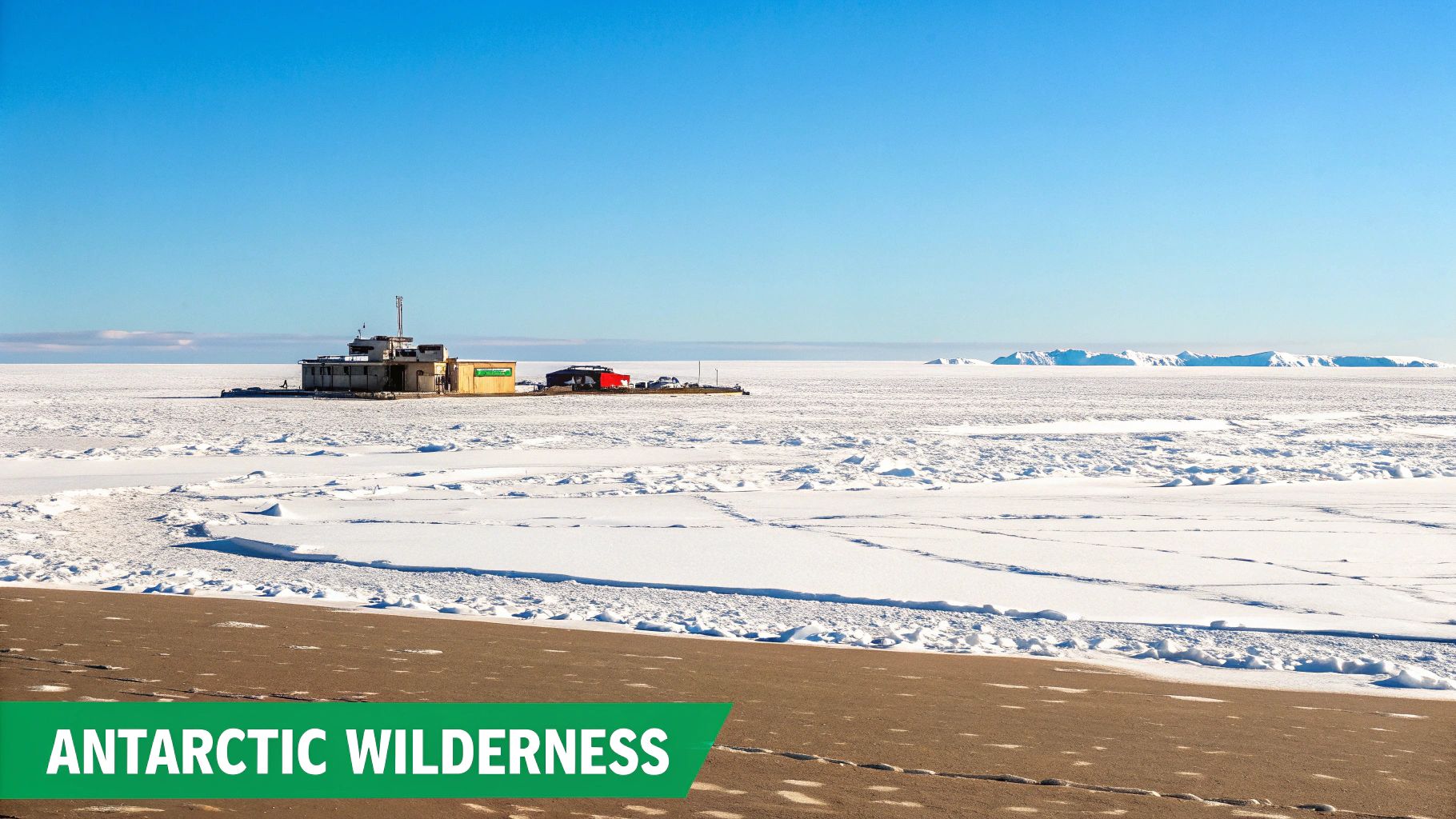
Our global tour wraps up with two continents that couldn't be more different. We'll start with Australia, the smallest of the seven and the only one that's also a single country. It’s a land defined by its sun-scorched Outback, incredible coral reefs, and wildlife that looks like it came from another planet.
When you think of Australia, you probably picture kangaroos bounding across vast, red plains or koalas snoozing in eucalyptus trees. That incredible isolation allowed nature to run wild, creating an ecosystem you won't find anywhere else. For EarthChasers players, this means missions packed with unique challenges, from navigating the Great Barrier Reef to surviving the rugged, remote bush.
The Icy Realm of Antarctica
Next, we journey to the very bottom of the world—Antarctica. This is a continent of extremes: it's the coldest, driest, and highest continent on average. It's home to about 90% of the world's ice and an incredible 70% of its freshwater. Unlike Australia, it’s a place almost entirely empty of permanent human settlement.
Antarctica isn’t a country. It’s a pristine wilderness governed by an international treaty, dedicated entirely to peace and scientific research. Picture a world of towering glaciers, enormous ice shelves, and wildlife perfectly built for the harshest conditions imaginable, like emperor penguins and leopard seals.
Australia and Antarctica throw our planet's incredible diversity into sharp relief. One is a continent bursting with unique, warm-blooded life, while the other is an icy desert governed by science and international cooperation.
These last two destinations in your EarthChasers journey offer a masterclass in contrast, from the sun-drenched coasts of Sydney to the frozen frontiers of the South Pole. Each gives you a totally different perspective on what makes a continent, completing your tour of Earth's amazing landmasses.
A Few Common Questions About the Continents
As you start to explore the globe, a few common questions always seem to pop up. Let's tackle some of the big ones to help sharpen your world knowledge.
Why Are Europe and Asia Separate Continents?
This is a great question. Even though Europe and Asia are connected on one giant landmass—often called Eurasia—they're treated as separate continents for deep cultural and historical reasons.
The split isn't based on an ocean or a clear physical divide. Instead, it's a human distinction that has developed over thousands of years, with the Ural Mountains often serving as a rough border. Think of it less as a geological rule and more as a story of two regions with their own unique histories, languages, and identities.
Is Greenland a Continent?
Nope, it’s not! While Greenland is the world's largest island, it doesn't qualify as a continent.
Geographically, it’s part of North America. Continents are defined by their sheer scale and their position on distinct tectonic plates. As massive as Greenland is, it just doesn’t meet that continental threshold.
It's worth remembering that even how we count continents isn't set in stone. The seven-continent model is standard in most English-speaking countries, but it's not the only way. Some models combine the Americas into one, while others group Europe and Asia together.
If you're looking to build a stronger foundation in all this, our guide on how to learn world geography is packed with practical tips. This flexibility just goes to show that geography is a living, evolving field of study!
Ready to stop just reading about the world and actually start exploring it? Join the adventure in EarthChasers and turn what you've learned into a thrilling global quest.
